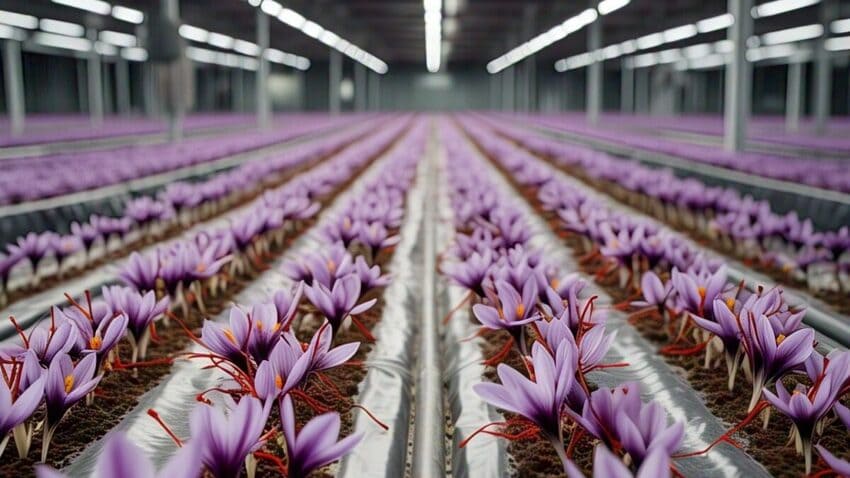
Smart Soilless Cultivation of Saffron: Enhancing Yield and Quality Through IoT-Integrated Hydroponic Systems
Title
Smart Soilless Cultivation of Saffron: Enhancing Yield and Quality Through IoT-Integrated Hydroponic Systems
Author
1. Ajeet Parmar,
Student, Bihar Agricultural University (BAU), Sabour, India
2. Kudrat Chaudhari,
Professor, Bihar Agricultural University (BAU), Sabour, India
Abstract
Saffron the most valuable spice by weight, is traditionally cultivated in soil under specific agro-climatic conditions. However, conventional methods face multiple challenges, including climate dependency, soil-borne diseases, and inconsistent yields. To overcome these limitations, soilless cultivation, particularly hydroponics, integrated with Internet of Things (IoT) technology, has emerged as a transformative solution. This paper explores the current advancements in smart saffron farming through IoT-integrated hydroponic systems, emphasizing yield enhancement, quality assurance, real-time monitoring, and resource optimization. Drawing from recent studies and implementations, we present a comprehensive overview of technological interventions and their impact on sustainable saffron production. Our findings indicate that integrating smart sensors, cloud platforms, and automation significantly improves cultivation efficiency, standardizes output quality, and promotes year-round production.
Keywords
Conclusion
IoT-integrated hydroponic systems represent a paradigm shift in saffron cultivation, offering controlled environments, enhanced yield, and consistent quality. By leveraging real-time monitoring, automation, and data analytics, these systems overcome traditional farming challenges and pave the way for sustainable, high-efficiency saffron production. Continued innovation and stakeholder collaboration are essential for mainstream adoption and scalability.
The future of saffron lies in the intersection of biology, engineering, and information technology—a smart farm where precision meets tradition for a golden harvest.
Author Contrubution
The author handled all aspects of the study, including its design, data collection, analysis, and manuscript preparation.
Funding
No specific grants from any funding agencies in the public, commercial, or non-profit sectors were received for this research, authorship, or publication.
Conflict of Interest
All authors declare that they have no conflicts of interest.
Data Sharing Statement
Not applicable.
Software And Tools Use
Not applicable.
Acknowledgements
I express my gratitude to those who provided expertise and assistance throughout this study and manuscript preparation. Special thanks to the anonymous peer reviewers for their valuable feedback.
Corresponding Author
Ajeet Parmar
Bihar Agricultural University (BAU), Sabour, Student, India
Kudrat Chaudhari
Bihar Agricultural University (BAU), Sabour, Professor, India
Copyright
Copyright: ©2025 Corresponding Author. This is an open access article distributed under the terms of the Creative Commons Attribution License , which permits unrestricted use, distribution, and reproduction in any medium, provided the original author and source are credited.
Parmar, Ajeet, and Chaudhari, Kudrat. “Smart Soilless Cultivation of Saffron: Enhancing Yield and Quality Through IoT-Integrated Hydroponic Systems.” Scientific Research Journal of Biology and Life Science, vol. 3, no. 1, 2025, pp. 24-29, https://isrdo.org/journal/SRJBL/currentissue/smart-soilless-cultivation-of-saffron-enhancing-yield-and-quality-through-iot-integrated-hydroponic-systems
Parmar, A., & Chaudhari, K. (2025). Smart Soilless Cultivation of Saffron: Enhancing Yield and Quality Through IoT-Integrated Hydroponic Systems. Scientific Research Journal of Biology and Life Science, 3(1), 24-29. https://isrdo.org/journal/SRJBL/currentissue/smart-soilless-cultivation-of-saffron-enhancing-yield-and-quality-through-iot-integrated-hydroponic-systems
Parmar Ajeet and Chaudhari Kudrat, Smart Soilless Cultivation of Saffron: Enhancing Yield and Quality Through IoT-Integrated Hydroponic Systems, Scientific Research Journal of Biology and Life Science 3, no. 1(2025): 24-29, https://isrdo.org/journal/SRJBL/currentissue/smart-soilless-cultivation-of-saffron-enhancing-yield-and-quality-through-iot-integrated-hydroponic-systems
2210
Total words1068
Unique Words118
Sentence18.237288135593
Avg Sentence Length0.28308346785042
Subjectivity0.068369400726392
PolarityText Statistics
Viewed / Downloads
Total article views: 399 (including HTML, PDF, and XML)| HTML | XML | Total | |
|---|---|---|---|
| 137 | 226 | 36 | 399 |
Viewed (geographical distribution)
Thereof 399 with geography defined and 0 with unknown origin.